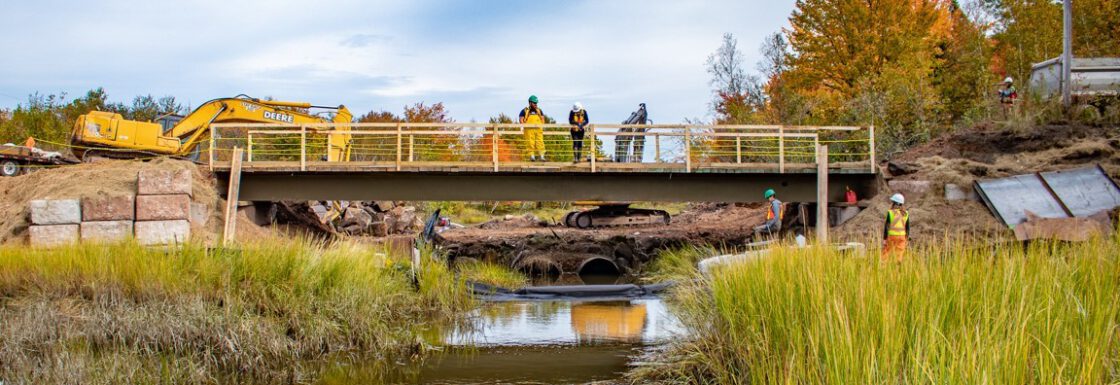Building Bridges: NS Salt Marsh Restoration: Clean Foundation

Projects Sponsor
Clean Foundation’s Salt Marsh Restoration “Building Bridges” program, funded by Fisheries and Oceans Canada, restored a salt marsh in Northern Nova Scotia that is key for fish habitat and climate change resilience and important to the Mi’kmaw people. Using a participatory approach and best practices cultivated from partnerships with over twenty groups across North America, Clean replaced degraded harmful infrastructure with a bridge that allowed for natural ecosystem dynamics to resume across seven hectares of habitat.

As a result of human activity, salt marshes along the Northumberland Strait of Nova Scotia have suffered widespread degradation. It’s estimated a devastating 65% of this habitat––vital for healthy fisheries, coastlines, and communities—has been lost. Over the years, much of the salt marsh was dyked and converted to farmland and in the 1960s and 1970s the Province of Nova Scotia began replacing bridges with undersized culverts which limit the ability of tidal water to flow in and out of these systems. They cut the salt marshes’ connection to the sea.
Salt marshes are an integral part of the region’s economy and culture. They provide food, refuge, and nursery habitat for many fish species. They protect shorelines from erosion by buffering wave action and trapping sediments. Salt marshes also mitigate against flooding, strong waves and storm surges by slowing and absorbing rainwater and protecting water quality by filtering runoff.
Finally, salt marshes hold and store carbon and so conserving and restoring them offers opportunities for slowing climate change. In Nova Scotia, where 70% of the population lives in coastal communities and experiences the threats of climate change first-hand, the need for healthy salt marshes is particularly pertinent.
The Clean team prioritized and worked to incorporate Mi’kmaw perspectives into all aspects of the project. Mi’kmaw Elders, traditional fishers, hunters and trappers, and community members were asked to provide their traditional knowledge. The team completed interviews and listened to personal stories in order to understand traditional activities more fully in culturally significant areas. The goal was to incorporate culturally important priorities and activities throughout the restoration process.
Clean also collected technical, community and traditional Indigenous knowledge to better understand the historic extent of salt marsh habitat and the cultural and social significance salt marshes have for coastal communities in Nova Scotia. Community engagement sessions were hosted and Clean conducted a traditional Indigenous knowledge study, visiting sites to learn from community members and respected elders.
This engagement work allowed Clean to incorporate community knowledge and an Indigenous way of knowing into the site selection process and to be mindful of best practices when it comes to respectfully engaging with Mi’kmaw communities. Community engagement provided critical input for the selection of restoration sites, which was done in partnership with local communities, and with their full assent.
This process culminated in the selection of Marshalls Crossing, a site where a road passed through a salt marsh, effectively cutting it in two, isolating the more inland portion of the salt marsh away from the natural ebbs and flows of tidal water that would, under normal conditions, flush out the area twice a day.
The only connection between the seaward and inland portions of the site was a pair of failing and under-sized culverts that did not allow for sufficient flows of water between the two halves of the salt marsh. The result was an inland marsh that was blocked off for migratory fish passage and which did not reflect the distribution of salt marsh plants and animals that would have been present historically.
The team received training from several expert partners, including local wetland restoration specialist CB Wetlands and Environmental Specialists (CBWES). These organizations provided valuable coaching on salt marsh ecology, assessment protocols and tidal barrier remediation that helped the team update existing protocols and acquire the best equipment to collect good data that could be used by other groups in the province.
Field visits with American expert partners the Chesapeake Bay Foundation, Tampa Bay Watch and Save the Bay Narrangansett were conducted. Here, best practices in monitoring protocols, restoration methodologies, educational and outreach programs, and volunteer retention were shared, all leading to the implementation of new and innovative restoration and engagement techniques in Nova Scotia.
For sites that were assessed but not selected as candidate restoration sites, the team developed restoration recommendation reports and shared these free online with the public so that other groups in the future might be able to carry out this work.
At the Marshalls Crossing site failing culverts were replaced with a bridge, restoring 7ha of habitat that allowed the return to proper tidal flow and improved salt marsh habitat and fish passage.
Throughout the project, capacity building was a major priority. Engagement and training activities, including workshops, volunteer/intern recruitment, citizen science events, town halls, and presentations laid the groundwork for deeper relationships, continued two-way knowledge transfer, and more involved community participation. These activities contribute to the overall goal of providing skills, training and experience that will translate into the development of communities’ capacity to conduct future restoration work in the Northumberland Strait region of mainland Nova Scotia.













